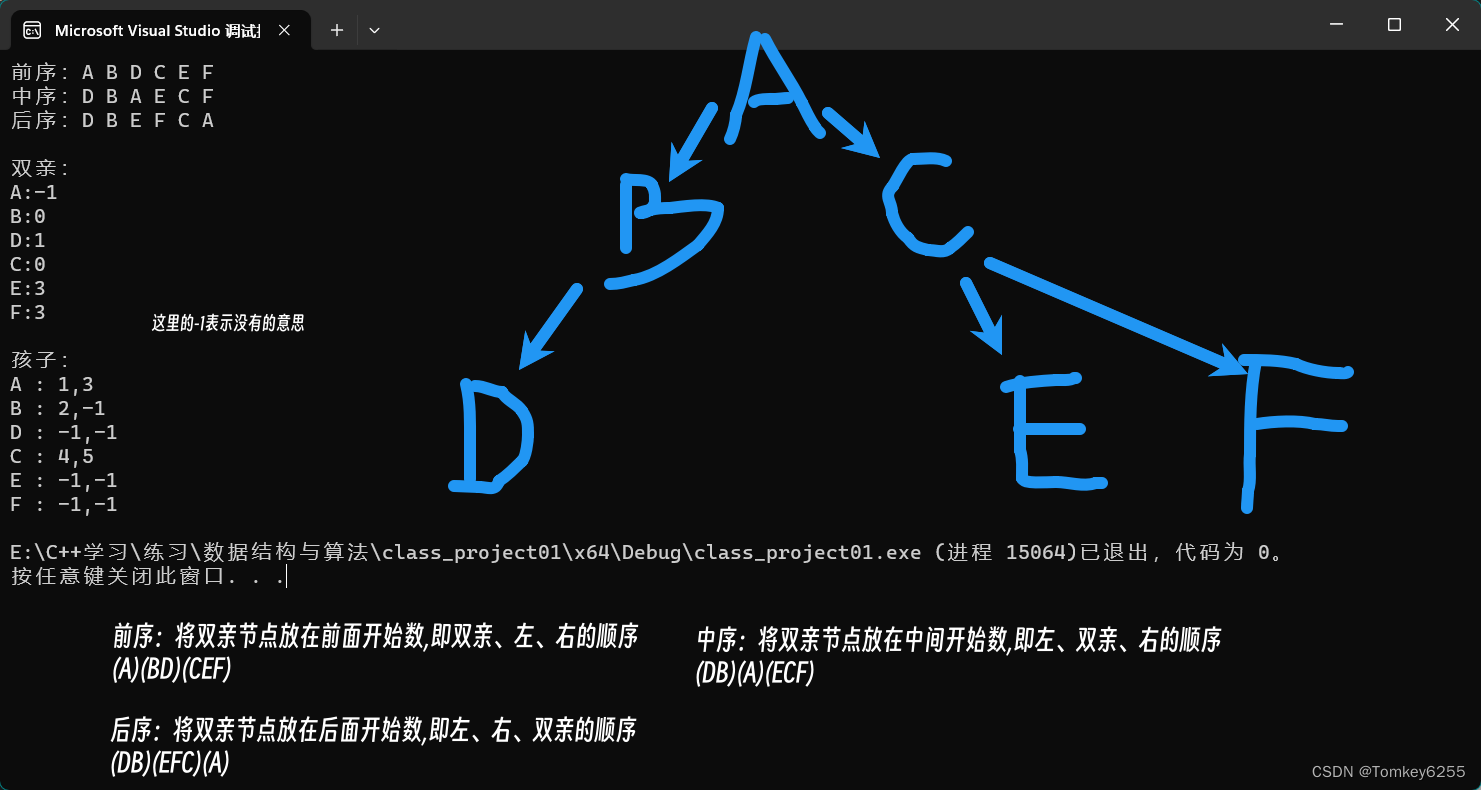图片如下:
图中列举的双亲表示法以及孩子表示法是在前序遍历的基础上的
前序遍历:将双亲节点放在前面开始数,即双亲、左、右的顺序,如A)(BD)(CEF)
//前序
void FirstRoot(BinaryNode *root)
{
if (root == nullptr)
{
return;
}
VisttorNode(root);//注意
FirstRoot(root->GetLeftChild());
FirstRoot(root->GetRightChild());
}中序遍历:将双亲节点放在中间开始数,即左、双亲、右的顺序,如(DB)(A)(ECF)
//中序
void MidRoot(BinaryNode* root)
{
if (root == nullptr)
{
return;
}
MidRoot(root->GetLeftChild());
VisttorNode(root);//注意
MidRoot(root->GetRightChild());
}后序遍历:将双亲节点放在后面开始数,即左、右、双亲的顺序,如(DB)(EFC)(A)
//后序
void LastRoot(BinaryNode* root)
{
if (root == nullptr)
{
return;
}
LastRoot(root->GetLeftChild());
LastRoot(root->GetRightChild());
VisttorNode(root);//注意
}ps.这三种遍历在代码上实现是非常简单的,就是递归调用,不同之处在于开始的顺序不同。
双亲表示法以及孩子表示法
//双亲表示法
//这里暂时使用中序的遍历方法,放入到list中
void FirstRootList(BinaryNode* root,vector<BinaryNode*>&list)
{
if (root == nullptr)
{
return;
}
list.push_back(root);
FirstRootList(root->GetLeftChild(), list);
FirstRootList(root->GetRightChild(), list);
}
//这里使用中序遍历试试
void MidRootList(BinaryNode* root, vector<BinaryNode*>& list)
{
if (root == nullptr)
{
return;
}
MidRootList(root->GetLeftChild(), list);
list.push_back(root);
MidRootList(root->GetRightChild(), list);
}
//找到双亲表示法需要的双亲的下标,这个list目前是按照前序遍历放置的
int FindIndex(vector<BinaryNode*>list, BinaryNode* node)
{
for (int i=0;i<list.size();++i)
{
if (list[i] == node)
{
return i;
}
}
return -1;
}
void PrintParentPresent(BinaryNode* root)
{
vector<BinaryNode*>list;
//用前序排列
//FirstRootList(root, list);
//用中序遍历试试
MidRootList(root, list);
for (int i = 0; i < list.size(); ++i)
{
BinaryNode* node = list[i];
int parentIndex = -1;
//找到它的双亲节点
BinaryNode* parent = node->GetParent();
if (parent != nullptr)
{
//找到双亲节点的下标,返回
parentIndex = FindIndex(list, parent);
}
//printf("%s : %d \r\n", node->GetObject().val, parentIndex);
cout << node->GetObject().val << ":" << parentIndex << endl;
}
}
//孩子表示法
void PrintChildPresent(BinaryNode* root)
{
vector<BinaryNode*>list;
//用前序排列
//FirstRootList(root, list);
//用中序遍历试试
MidRootList(root, list);
for (int i = 0; i < list.size(); ++i)
{
BinaryNode* node = list[i];
int leftChildIndex = -1;
int rightChildIndex = -1;
BinaryNode* leftChild = node->GetLeftChild();
BinaryNode* rightChild = node->GetRightChild();
if (leftChild != nullptr)
{
leftChildIndex = FindIndex(list, leftChild);
}
if (rightChild != nullptr)
{
rightChildIndex = FindIndex(list, rightChild);
}
//打印这个节点的值,以及它的孩子的下标
//printf("%s : %d , %d \r\n", node->GetObject().val, leftChildIndex, rightChildIndex);
cout << node->GetObject().val << " : " << leftChildIndex << "," << rightChildIndex << endl;
}
}全部代码如下:
//二叉树
#include <string>
#include <iostream>
#include <vector>
/*
用printf("%s")输出字符串是乱码的,得用cout...无语了
*/
using namespace std;
//内容
class Object
{
public:
string val;
};
//节点
class BinaryNode
{
//双亲
BinaryNode* Parent;
//内容
Object obj;
//左边,右边
BinaryNode* LeftChild;
BinaryNode* RightChild;
public:
//构造函数,初始化
BinaryNode()
{
Parent = nullptr;
LeftChild = nullptr;
RightChild = nullptr;
obj.val = {0};
}
//创造节点
static BinaryNode* CreatNode(Object o)
{
BinaryNode* newNode = new BinaryNode();
newNode->SetObject(o);//输入内容
return newNode;
}
//得到节点内容
Object GetObject()
{
return obj;
}
//输入内容·
void SetObject(Object o)
{
obj = o;
}
BinaryNode* GetParent()
{
return Parent;
}
BinaryNode* GetLeftChild()
{
return LeftChild;
}
BinaryNode* GetRightChild()
{
return RightChild;
}
void SetLeftChild(BinaryNode* child)
{
LeftChild = child;
child->Parent = this;
}
void SetRightChild(BinaryNode* child)
{
RightChild = child;
child->Parent = this;
}
};
//访问节点,输出节点内容
void VisttorNode(BinaryNode* node)
{
if (node != nullptr)
{
/*printf("%s ", node->GetObject().val);*/
cout << node->GetObject().val << " ";
}
}
//前序
void FirstRoot(BinaryNode *root)
{
if (root == nullptr)
{
return;
}
VisttorNode(root);
FirstRoot(root->GetLeftChild());
FirstRoot(root->GetRightChild());
}
//中序
void MidRoot(BinaryNode* root)
{
if (root == nullptr)
{
return;
}
MidRoot(root->GetLeftChild());
VisttorNode(root);
MidRoot(root->GetRightChild());
}
//后序
void LastRoot(BinaryNode* root)
{
if (root == nullptr)
{
return;
}
LastRoot(root->GetLeftChild());
LastRoot(root->GetRightChild());
VisttorNode(root);
}
//双亲表示法
//这里暂时使用中序的遍历方法,放入到list中
void FirstRootList(BinaryNode* root,vector<BinaryNode*>&list)
{
if (root == nullptr)
{
return;
}
list.push_back(root);
FirstRootList(root->GetLeftChild(), list);
FirstRootList(root->GetRightChild(), list);
}
//这里使用中序遍历试试
void MidRootList(BinaryNode* root, vector<BinaryNode*>& list)
{
if (root == nullptr)
{
return;
}
MidRootList(root->GetLeftChild(), list);
list.push_back(root);
MidRootList(root->GetRightChild(), list);
}
//找到双亲表示法需要的双亲的下标,这个list目前是按照前序遍历放置的
int FindIndex(vector<BinaryNode*>list, BinaryNode* node)
{
for (int i=0;i<list.size();++i)
{
if (list[i] == node)
{
return i;
}
}
return -1;
}
void PrintParentPresent(BinaryNode* root)
{
vector<BinaryNode*>list;
//用前序排列
//FirstRootList(root, list);
//用中序遍历试试
MidRootList(root, list);
for (int i = 0; i < list.size(); ++i)
{
BinaryNode* node = list[i];
int parentIndex = -1;
//找到它的双亲节点
BinaryNode* parent = node->GetParent();
if (parent != nullptr)
{
//找到双亲节点的下标,返回
parentIndex = FindIndex(list, parent);
}
//printf("%s : %d \r\n", node->GetObject().val, parentIndex);
cout << node->GetObject().val << ":" << parentIndex << endl;
}
}
//孩子表示法
void PrintChildPresent(BinaryNode* root)
{
vector<BinaryNode*>list;
//用前序排列
//FirstRootList(root, list);
//用中序遍历试试
MidRootList(root, list);
for (int i = 0; i < list.size(); ++i)
{
BinaryNode* node = list[i];
int leftChildIndex = -1;
int rightChildIndex = -1;
BinaryNode* leftChild = node->GetLeftChild();
BinaryNode* rightChild = node->GetRightChild();
if (leftChild != nullptr)
{
leftChildIndex = FindIndex(list, leftChild);
}
if (rightChild != nullptr)
{
rightChildIndex = FindIndex(list, rightChild);
}
//打印这个节点的值,以及它的孩子的下标
//printf("%s : %d , %d \r\n", node->GetObject().val, leftChildIndex, rightChildIndex);
cout << node->GetObject().val << " : " << leftChildIndex << "," << rightChildIndex << endl;
}
}
int main()
{
Object objA;
objA.val = "A";
BinaryNode* nodeA = BinaryNode::CreatNode(objA);
Object objB;
objB.val = "B";
BinaryNode* nodeB = BinaryNode::CreatNode(objB);
Object objC;
objC.val = "C";
BinaryNode* nodeC = BinaryNode::CreatNode(objC);
Object objD;
objD.val = "D";
BinaryNode* nodeD = BinaryNode::CreatNode(objD);
Object objE;
objE.val = "E";
BinaryNode* nodeE = BinaryNode::CreatNode(objE);
Object objF;
objF.val = "F";
BinaryNode* nodeF = BinaryNode::CreatNode(objF);
//连接
nodeA->SetLeftChild(nodeB);
nodeA->SetRightChild(nodeC);
nodeB->SetLeftChild(nodeD);
nodeC->SetLeftChild(nodeE);
nodeC->SetRightChild(nodeF);
BinaryNode* root = nodeA;
cout << "前序:";
FirstRoot(root);
cout << endl;
cout << "中序:";
MidRoot(root);
cout << endl;
cout << "后序:";
LastRoot(root);
cout << endl;
cout << endl;
cout << "双亲:" << endl;
PrintParentPresent(root);
cout << endl;
cout << "孩子:" << endl;
PrintChildPresent(root);
return 0;
}必看:(✿◡‿◡)
点赞,收藏,分享,加关注ψ(`∇´)ψ





















 693
693

 被折叠的 条评论
为什么被折叠?
被折叠的 条评论
为什么被折叠?








